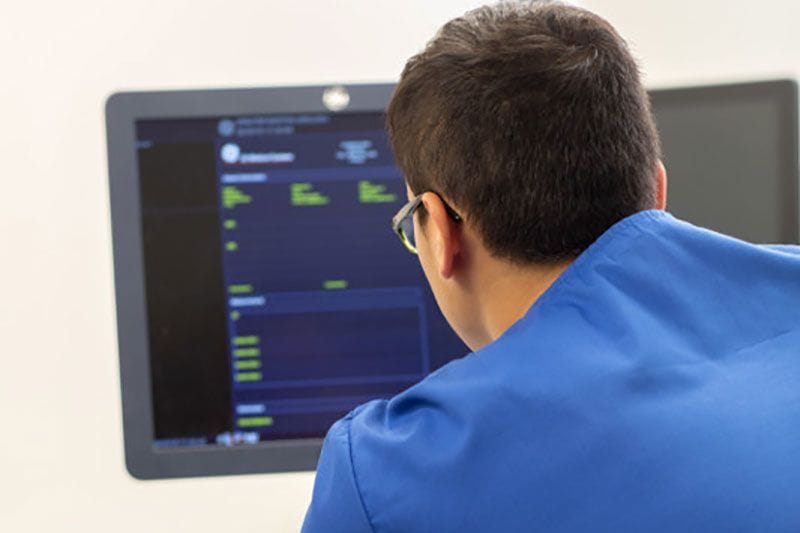Healthcare occupations are projected to add more jobs than any other occupational group. The US Bureau of Labor Statistics predicts that more than 2.6 million new healthcare-related jobs will be added due to the aging population and increased need for healthcare services. As an academic coach primarily for healthcare clients, I talk to employees interested in pursuing a career in healthcare that is clinical in nature. Many of them are unsure what options exist, the education requirements needed, or the pathway to get there. There are dozens of career options in Allied Health that are both clinical and non- clinical. The Association of Schools Advancing Health Professions (ASAHP) defines Allied Health as health professions distinct from medicine and nursing. This blog will focus on Diagnostic Imaging, which is a small cluster of career options under the Allied Health umbrella.
What Is Medical Imaging?
Medical Imaging Technology, also known as Diagnostic Imaging, has been ranked by the New England Journal of Medicine and many other peer reviewed medical journals as one of the top medical developments over the past thousand years. Medical Imaging refers to a variety of different non-invasive technologies used to look inside the body. With these technologies, it is possible to see how inner organs are functioning, joints are moving, and much more.
Diagnostic imaging does everything from confirming the presence of disease or illness to determining the cause or severity of an illness/injury. It is also used to assist with providing strategies for upcoming surgical procedures and/or determining how well your body is responding to a treatment from an illness or injury.
Each technology provides data about the area being explored or treated. This imaging has revolutionized health care, allowing for earlier diagnoses of diseases, better patient outcomes, and reduced the need for undue invasive exploratory procedures.
There are many medical imaging specializations, but this blog will outline four popular career options: Radiographer, Magnetic Resonance Imaging (MRI) Technologist, Diagnostic Medical Sonographer, and Computed Tomography (CT) Technologist.
Radiography is the building block for many educational paths and careers in Medical Imaging including MRI and CT (which are specializations for licensed Radiographers). The educational training programs to further specialize within radiography require national certification or years of experience for admission into their programs and employers often prefer experience as a Radiographer.
What Is a Radiographer?
A radiographer, also known as an x-ray technician or radiology technologist, is an Allied Health professional who specializes in the use of x-rays and other diagnostic technologies. Radiographers perform tests as directed by the practitioner and then provide the images to the radiologist to read and interpret.
Most entry-level positions require an associate degree and professional certification. Some positions may also require state licensure. Outside of associate degree programs, there are 2-year hospital certificate programs and 4-year bachelor degree programs that may be available in your state. Academic programs in radiologic technology are comprised of courses in anatomy and physiology, pathology, patient care, medical ethics, radiation physics and protection, and image evaluation. Associate degree programs are a blend of classroom and clinical courses and can often be completed in two years full-time.
According to the U.S. Bureau of Labor Statistics, the annual median pay for Radiologic Technologists is $61,900. The job outlook for x-ray technologists shows faster growth then average with a predicted growth of 7% by 2029. Career opportunities for radiologic technologists are available in hospitals, imaging centers, private medical offices, sales, research, and the commercial arena.
What Is a Diagnostic Medical Sonographer?
Diagnostic Medical Sonographers use imaging equipment and soundwaves to create images of different parts of the body. These images are referred to as ultrasounds. Sonographers are trained to analyze the images while conducting the scan to ensure they are quality images and they are covering the entire organ or area they were tasked to image. Due to the non-invasive nature of ultrasound, it is often one of the first tests ordered by a provider when disease is detected. Sonographers can choose a specialty. Options can include: abdominal, breast, musculoskeletal, neurology, obstetrics and gynecology, and cardiology.
Sonography programs vary from 1 to 4 years. Individuals with experience in radiography may be able to complete a 1-year certificate program. Typically, these 12-month programs require an associate degree in radiologic technology and American Registry of Radiologic Technologists (ARRT) certification for admission. Two-year programs award an associate degree in Diagnostic Medical Sonography and provide a background in physical and biological sciences, algebra, and communication skills.
According to the U.S. Bureau of Labor Statistics, Medical Sonographers median pay is $70,380 annually. The job outlook for MRI Technologists shows faster growth than average with predicted growth of 14% by 2029. Sonographers are employed in hospital settings, medical/diagnostic laboratories, and physician offices.
What Is a Computed Tomography (CT) Technologist?
A Computed Tomography (CT) Technologist is a Radiologic Technologist that uses specialized computerized x-ray equipment to provide cross sectional internal images of the human body. CT Technologists work closely with important members of the healthcare team providing images to radiologists that assist with patient diagnosis and treatment of many diseases and disorders.
While CT Technologists hold an associate degree in radiologic sciences, this is not an entry-level option and requires further training. Many community colleges and professional organizations offer specialized training for individuals interested in a career in Computed Tomography and on the job training may be available to experienced radiographers. Most employers require, at a minimum, licensure as a radiographer by the ARRT. Some employers may also require state licensure as well as advanced certification in CT scanning from the ARRT.
According to the U.S. Bureau of Labor Statistics, the median annual pay for CT Technologists is $63,710. The job outlook for CT Technologists shows faster growth then average, with a predicted growth of 9% by 2029. Career opportunities for CT technologist are found in hospitals, imaging centers, private medical offices, and sales.
What Is a Magnetic Resonance Imaging (MRI) Technologist?
An MRI Technologist specializes in the operation of magnetic resonance imaging scanners, big tubular machines that use magnetic fields and radio waves, to obtain scans which create images of a patient’s bones, organs, and tissue. MRI technologists are responsible for positioning the patient, operating the machines, and ensuring they have captured the best images possible. MRI machines are loud, and for some, create anxiety. An MRI technologist works closely with patients, educating and preparing them for what to expect and helps them to be more comfortable throughout the scan.
MRI technologist programs vary in length based upon one’s previous education. Individuals who already possess professional certification in diagnostic imaging can expand their scope of practice and pursue certification as an MRI Technologist by completing an accredited certificate or bachelor’s completion program. Oftentimes, individuals pursuing MRI hold an associate or bachelor’s degree as well as national certification as a radiologic technologist or nuclear medicine technologist. Preparation for advanced certification as an MRI technologist is composed of didactic and clinical education to meet the requirements set forth by the American Registry of Radiologic Technologists (ARRT) or the American Registry of Magnetic Resonance Imaging Technologists (ARMRIT).
According to the U.S. Bureau of Labor Statistics, Magnetic Resonance Imaging Technologists median pay is $74,690 annually. The job outlook for MRI Technologists shows faster growth then average, with predicted growth of 9% by 2029. Career opportunities for MRI technologists range from hospitals, specialized physician clinics, medical and diagnostic laboratories, imaging centers, and mobile imaging companies.
As healthcare occupations are projected to drastically increase in the next decade, Medical Imaging clinicians will be in demand. A career in Medical Imaging allows individuals the opportunity for a rewarding career without a long education, the opportunity to work in a variety of settings, and to play a critical role in healthcare. It offers a good salary without an advanced degree while still allowing for advancement.





